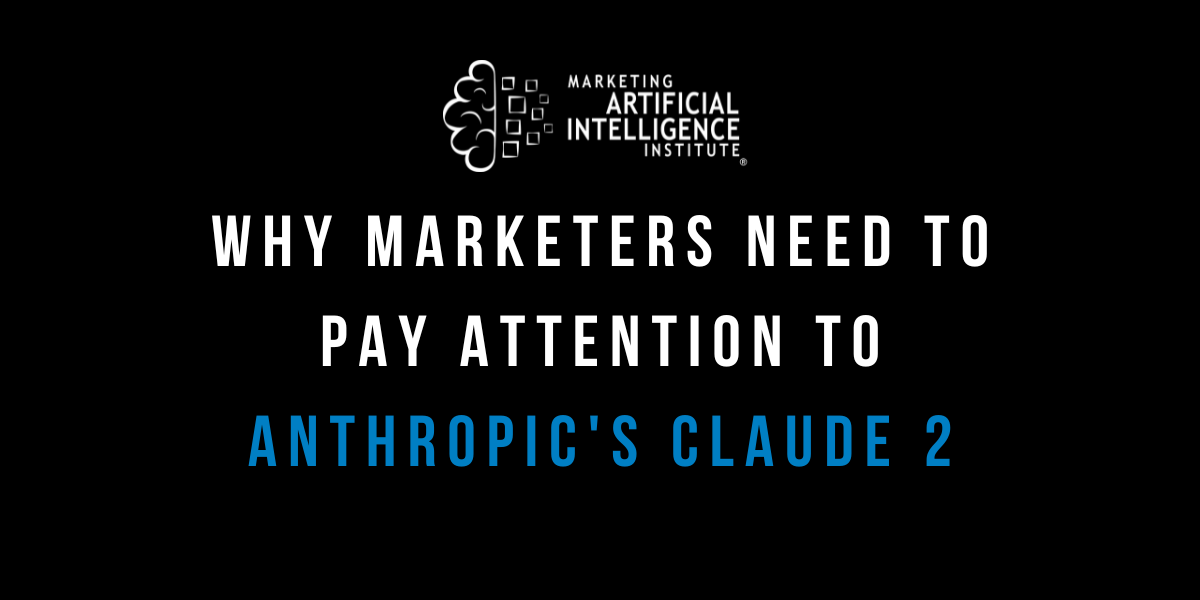Claude 2 from Anthropic is a powerful new AI tool that marketers need to pay attention to.
Anthropic, a major AI company, just announced the release of Claude 2, its new, more powerful AI foundation model.
And marketers need to be paying attention because Claude 2’s improved capabilities unlock seriously impressive use cases in marketing and business.
“It’s quite significant,” says Marketing AI Institute founder/CEO Paul Roetzer. “I would say it’s probably the closest thing to GPT-4 that I’ve personally experienced.”
Here’s what you need to know.
What Is Claude 2?
Myself and Marketing AI Institute founder/CEO Paul Roetzer discussed Claude 2 in-depth on Episode 55 of The Marketing AI Show.
First off, what is it?
Claude 2 is a large language model developed by Anthropic. Like with ChatGPT, Claude 2 responds to your natural language prompts. You can use it to generate text, answer questions, produce code, and much, much more.
It also has much stronger reasoning capabilities across math and code than its predecessor. (It scored above the 90th percentile on the GRE reading and writing exam.)
But, perhaps most importantly, Claude 2 now has a 100,000-token context window. Tokens are the individual parts of words that a model like Claude processes. For context, the most powerful version of GPT-4 has a 32,000-token context window. The standard version has an 8,000-token window.
That means you could comfortably upload the entire novel The Great Gatsby to Claude 2, which weighs in at about 72,000 tokens, with room to spare.
According to Anthropic: “This means that Claude can work over hundreds of pages of technical documentation or even a book.”
In fact, Claude 2 makes it easy to cut and paste in lots of text, upload PDFs, and upload CSVs, so you can use the model for a variety of use cases across huge amounts of material.
How Does Claude 2 Perform vs. Other Models?
To test Claude 2, our CEO, Paul, put it through its paces against other models for a very specific and relevant use case.
As part of a fireside chat at our annual Marketing AI Conference (MAICON) this year, Paul is interviewing AI expert Ethan Mollick. In preparation for that interview, Paul asked Claude 2, Google Bard, Inflection’s Pi, ChatGPT using GPT-3.5, and ChatGPT using GPT-4 with Code Interpreter for help.
He gave each tool a series of articles written by Mollick. For each article, Paul asked for a summary of each article and suggestions for 5-7 potential questions to ask Mollick.
By far, the top performers were Claude 2 and GPT-4.
“These summaries were incredible and the questions were deep,” Paul says. He also indicates that GPT-3.5 also did a solid job.
Surprisingly, Bard performed relatively poorly on this particular task. It summarized the articles, but, even with access to the internet, it left out obvious or important details.
Inflection’s Pi also had issues. Pi is supposed to be a more conversational and human-like agent than others. But this had downsides. Paul said that Pi continued to ask him questions over and over again, making comments and using emojis to humanize the conversation—but it didn’t actually do the task.
Paul ended up taking the results from Claude 2 and GPT-4, as well as his own questions, and merging them into a final list of 20-30 questions for the interview. About half of the possible questions ended up coming from the two tools.
In some cases, the two tools phrased questions better than Paul and pulled in additional context not in Mollick’s articles to create deeper, more useful summaries.
Should Marketers Use Claude 2?
“I know there’s a lot of competing products out there, but I think it’s worth paying attention to,” Paul says. If you haven’t, you should add Claude 2 to your list, especially given its extensive context window.
But, Paul says, you have to keep coming back to all of the major tools. They drastically change and improve in short amounts of time. Just because some of them failed this challenge doesn’t mean they won’t perform well on it in the future.
Paul recommends having 3-5 standard use cases that you use these types of tools for. Think things like: transcription, summarization, writing first drafts, etc. Every month or two, try those use cases across multiple tools and models—because they’re in a constant race where different models pull ahead at different times.
Don’t get left behind…
You can get ahead of AI-driven disruption—and fast—with our Piloting AI for Marketers course series, a series of 17 on-demand courses designed as a step-by-step learning journey for marketers and business leaders to increase productivity and performance with artificial intelligence.
The course series contains 7+ hours of learning, dozens of AI use cases and vendors, a collection of templates, course quizzes, a final exam, and a Professional Certificate upon completion.
After taking Piloting AI for Marketers, you’ll:
- Understand how to advance your career and transform your business with AI.
- Have 100+ use cases for AI in marketing—and learn how to identify and prioritize your own use cases.
- Discover 70+ AI vendors across different marketing categories that you can begin piloting today.
Mike Kaput
As Chief Content Officer, Mike Kaput uses content marketing, marketing strategy, and marketing technology to grow and scale traffic, leads, and revenue for Marketing AI Institute. Mike is the co-author of Marketing Artificial Intelligence: AI, Marketing and the Future of Business (Matt Holt Books, 2022). See Mike's full bio.

